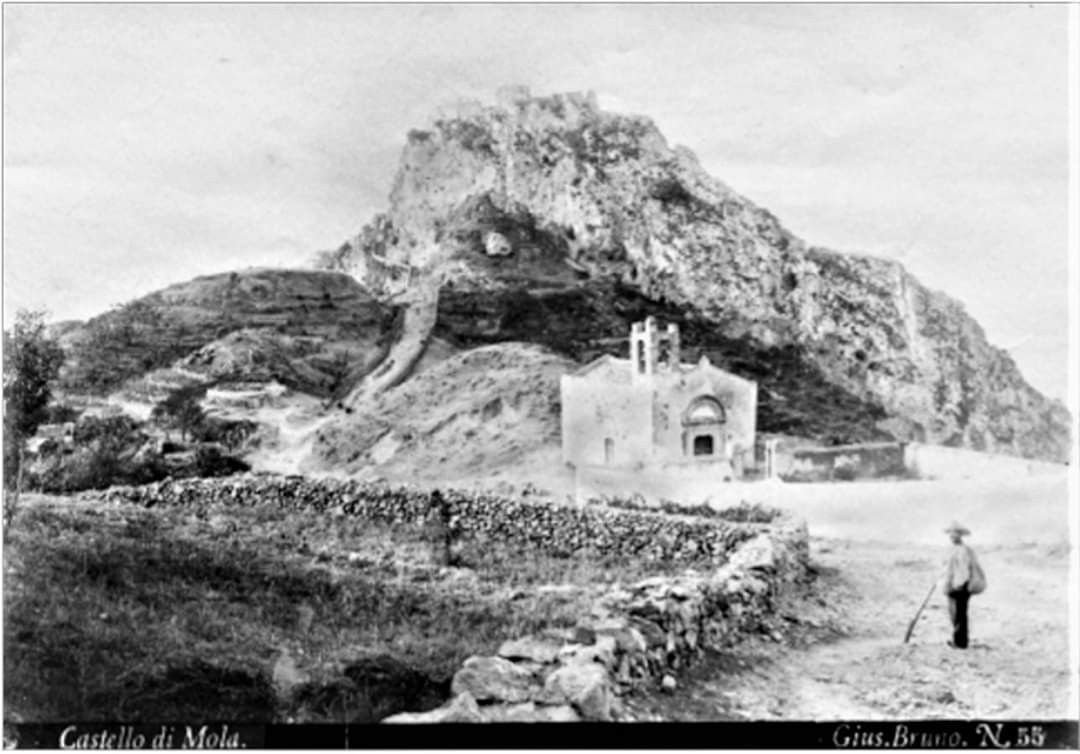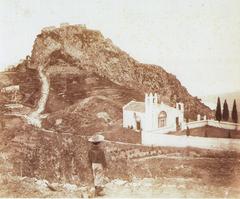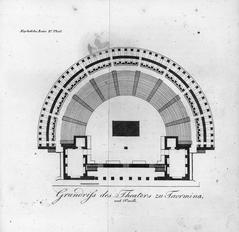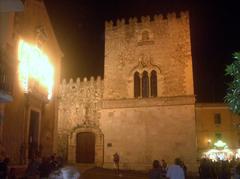
Comprehensive Guide to Visiting Piazza Sant’Antonio, Taormina, Italy
Date: 24/07/2024
Introduction
Nestled in the heart of Taormina, Italy, Piazza Sant’Antonio is a site that blends historical grandeur with contemporary charm. From ancient origins to its vibrant present, this square is a testament to the resilience and beauty of Taormina. The origins of Taormina itself date back to around 396 BC, following the destruction of nearby Naxos by Dionysius I of Syracuse in 403 BC. The survivors of Naxos, along with the indigenous Siculi, established a new settlement on Mount Taurus, which eventually grew into the city of Tauromenium, known today as Taormina (Wikipedia). The square, named after Saint Anthony, has been a focal point for the town’s social and religious activities for centuries. Whether you’re planning a visit or just curious about its rich history, this guide will walk you through everything you need to know.
Table of Contents
- Introduction
- Historical Background
- Visitor Information
- Nearby Attractions
- Special Events and Guided Tours
- Photographic Spots
- Conclusion
- FAQ
Historical Background
Origins and Early History
Piazza Sant’Antonio in Taormina, Italy, is steeped in rich historical significance. The origins of Taormina itself date back to around 396 BC, following the destruction of nearby Naxos by Dionysius I of Syracuse in 403 BC. The survivors of Naxos, along with the indigenous Siculi, established a new settlement on Mount Taurus, which eventually grew into the city of Tauromenium, known today as Taormina (Wikipedia).
Medieval Period
The medieval period saw Taormina flourish under various rulers, including the Byzantines, Arabs, and Normans. The Church of Sant’Antonio Abate, located just outside Porta Catania, was constructed in 1330. This church is a significant landmark in Piazza Sant’Antonio and has undergone numerous transformations over the centuries (The World of Sicily).
Architectural Evolution
The architectural style of the Church of Sant’Antonio Abate is a fascinating blend of different periods. The original structure was destroyed during the bombings of 1943 but was meticulously rebuilt using the same materials recovered from the rubble. The current facade showcases a fusion of Gothic and Byzantine elements. The white limestone portal and the pointed arch above the lintel are characteristic of Gothic architecture, while the lead-plated windows with openwork decoration are of Byzantine origin (The World of Sicily).
Renaissance and Baroque Influences
During the Renaissance and Baroque periods, Taormina continued to develop its architectural and cultural landscape. The Church of San Giuseppe, another prominent structure in Piazza Sant’Antonio, is a magnificent example of Sicilian Baroque architecture. The church features a double staircase adorned with flowers, adding to its aesthetic appeal. This period also saw the construction of the historic clock tower, which, despite being destroyed multiple times, was always rebuilt (Vita Gazette).
Modern Era and World War II
The modern era brought significant changes to Taormina, particularly during World War II. The town was heavily bombed on July 9, 1943, resulting in extensive damage, especially near Porta Catania. Over 100 civilians lost their lives, and many historic buildings, including the Church of Sant’Antonio Abate, were destroyed. However, the resilience of the town’s inhabitants led to a remarkable recovery. By August 15, 1943, British troops had liberated Taormina, and the town began to rebuild and restore its cultural heritage (Savoring Italy).
Post-War Recovery and Cultural Renaissance
After World War II, Taormina experienced a cultural renaissance. The town became a haven for artists, writers, and intellectuals. Notable figures such as Bertrand Russell, Roald Dahl, and Tennessee Williams frequented Taormina, contributing to its reputation as a cultural hotspot. The restoration of historic sites, including the Church of Sant’Antonio Abate, played a crucial role in this revival. The church now houses a permanent nativity scene that reproduces the most important monuments of Taormina, serving as a testament to the town’s enduring cultural legacy (Savoring Italy).
Visitor Information
Visiting Hours and Tickets
Piazza Sant’Antonio is accessible to visitors 24/7. The Church of Sant’Antonio Abate typically opens from 9 AM to 6 PM, but it’s always best to check the latest visiting hours on the official Taormina tourism website. Entry is usually free, but donations for the church’s upkeep are appreciated.
Travel Tips
- Best Time to Visit: The ideal time to explore Piazza Sant’Antonio is during the spring or autumn when the weather is pleasant and the crowds are manageable.
- Getting There: Taormina can be reached by train, bus, or car from major cities like Catania and Messina. The nearest train station is Taormina-Giardini.
- What to Wear: Comfortable walking shoes are recommended due to the cobblestone streets and hilly terrain.
Nearby Attractions
- Greek Theatre: One of the most famous ancient theatres in the world, offering stunning views of Mount Etna and the Ionian Sea.
- Isola Bella: A beautiful island and nature reserve, perfect for a relaxing day trip.
- Corso Umberto: The main shopping street in Taormina, lined with boutiques, cafes, and historic landmarks.
Special Events and Guided Tours
- Annual Festivals: Taormina hosts several annual festivals, including the Taormina Film Fest and the Feast of San Pancrazio, offering a glimpse into the local culture and traditions.
- Guided Tours: Numerous guided tours are available that provide in-depth historical insights and access to lesser-known spots around Piazza Sant’Antonio.
Photographic Spots
- Views of Mount Etna: The square offers stunning views of Mount Etna, especially during sunset. The juxtaposition of the ancient architecture with the natural beauty makes for captivating photographs.
- Historic Landmarks: Both the Church of Sant’Antonio Abate and the historic clock tower provide excellent backdrops for photos.
Conclusion
Piazza Sant’Antonio is a rich tapestry of cultural and architectural evolution. From its origins in ancient times to its modern-day significance, the square embodies the resilience and beauty of Taormina. The blend of Gothic, Byzantine, and Baroque architectural styles, coupled with the town’s remarkable recovery from wartime destruction, makes Piazza Sant’Antonio a must-visit destination for anyone interested in history and culture.
FAQ
Q: What are the visiting hours for the Church of Sant’Antonio Abate? A: The church is typically open from 9 AM to 6 PM, but it’s advisable to check the latest visiting hours.
Q: How much does it cost to visit Piazza Sant’Antonio? A: Entry to the square is free. Donations for the upkeep of the Church of Sant’Antonio Abate are appreciated.
Q: What are some nearby attractions? A: Nearby attractions include the Greek Theatre, Isola Bella, and Corso Umberto.
Call to Action
Planning your visit to Taormina? Download the Audiala mobile app for more travel tips and updates. Don’t forget to check out our other related posts and follow us on social media for the latest news and events.
References
- Wikipedia. (n.d.). History of Taormina. Retrieved from https://en.wikipedia.org/wiki/History_of_Taormina
- The World of Sicily. (n.d.). Former Church of Sant’Antonio Abate, Taormina. Retrieved from https://www.theworldofsicily.com/en/sights/sights-of-taormina/former-church-of-sant-antonio-abate-taormina/
- Savoring Italy. (n.d.). Taormina, Sicily. Retrieved from https://www.savoringitaly.com/taormina-sicily/
- Vita Gazette. (n.d.). Hidden in Sicily since Ancient Roman and Ancient Greek Times, Taormina is One of Italy’s Pearls Representing Beauty, Resistance, Rebirth, and Strength. Retrieved from https://vitagazette.com/en/hidden-in-sicily-since-ancient-roman-and-ancient-greek-times-taormina-is-one-of-italys-pearls-representing-beauty-resistance-rebirth-and-strength/
- PlanetWare. (n.d.). Taormina Tourist Attractions. Retrieved from https://www.planetware.com/tourist-attractions-/taormina-i-si-ta.htm
- Travel Notes and Beyond. (n.d.). Things to Do in Taormina. Retrieved from https://travelnotesandbeyond.com/things-to-do-in-taormina/
- Eternal Arrival. (n.d.). Taormina Itinerary. Retrieved from https://eternalarrival.com/taormina-itinerary/
- Go Ask a Local. (n.d.). Travel Guide to Taormina, Sicily. Retrieved from https://goaskalocal.com/blog/travel-guide-to-taormina-sicily
- Julia’s Album. (n.d.). Castelmola. Retrieved from https://juliasalbum.com/castelmola/
- Solo Sophie. (n.d.). Taormina Itinerary. Retrieved from https://www.solosophie.com/taormina-itinerary/




